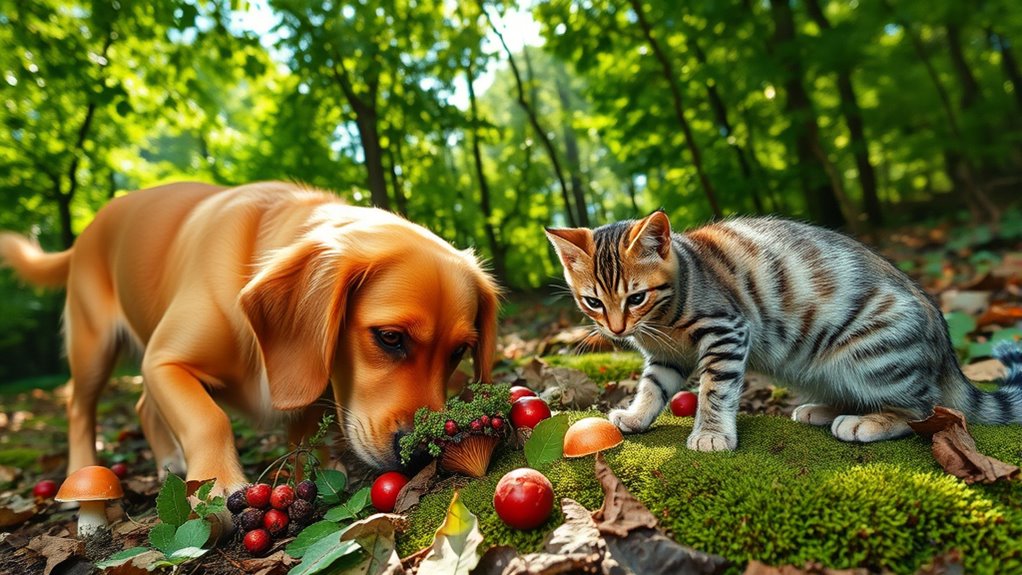To understand your pets’ natural foraging instincts, observe how dogs and cats hunt and scavenge in the wild. Dogs inherited pack hunting behaviors from wolves, while cats evolved as solitary hunters. You can enrich their lives by mimicking these instincts through scent trails, hide-and-seek, and puzzle toys. Creating a stimulating environment around foraging helps improve health and keeps their instincts sharp. Keep exploring to discover more ways to connect your pets with their wild roots.
Key Takeaways
- Dogs and cats retain natural foraging instincts from their wild ancestors, influencing their behaviors today.
- Incorporating wild foods like game meats and fish can enrich pets’ diets and satisfy innate foraging drives.
- Foraging activities, such as scent trails and puzzle toys, mimic natural hunting behaviors and promote mental stimulation.
- Proper safety measures, including vet consultation and safe environment setup, are essential when engaging pets in wild-like foraging.
- Routine foraging enhances pet health, reduces boredom, and supports natural instincts in a controlled, safe manner.
The Evolutionary Roots of Pet Foraging Instincts
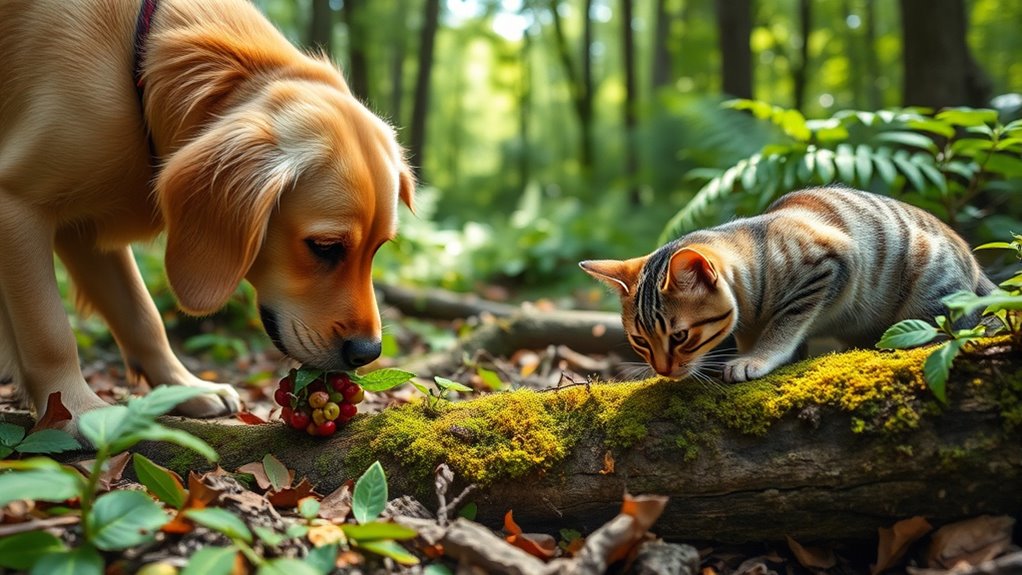
Understanding the evolutionary roots of pet foraging instincts helps explain why animals like dogs and cats behave the way they do today. Natural selection shaped traits that boost survival and reproduction, driving foraging behaviors in their ancestors.
Predator-prey dynamics show how essential foraging was for maintaining ecological balance. Environmental pressures influenced how different species developed specific strategies, while genetics played a key role in shaping these behaviors. genetic inheritance ensures that these innate tendencies are passed down and persist across generations.
Dogs, descended from wolves, inherited pack hunting and scavenging instincts, which they still display today. Additionally, behavioral traits are reinforced by domestication, yet the core foraging instincts remain evident.
Moreover, the environmental context in which these animals evolved continues to influence their foraging behaviors, even after domestication. Cats, evolving as solitary hunters, rely on stealth and ambush tactics.
Although domestication has altered some behaviors, both dogs and cats retain core instincts that reflect their evolutionary past, guiding how they seek and find food. Additionally, vetted models of pet behavior emphasize that these innate foraging tendencies remain significant in guiding pets’ actions even in a domestic setting.
Wild Foods That Complement Domestic Diets

Have you ever wondered how wild foods can enhance your pet’s diet? Incorporating wild foods like game meats, fish, and prey stomach contents offers a natural way to boost nutrition. Wild game such as rabbit, pheasant, venison, or elk provides high-quality protein and essential nutrients, often with less fat than commercial meats. Fish supplies omega fatty acids that promote healthy skin and coat. Prey stomach contents include plants and fruits, adding fiber and vitamins. Bones and offal deliver calcium and other minerals vital for bone strength. Using these wild ingredients can diversify your pet’s diet, supporting their natural instincts and health. The importance of balanced diets cannot be overstated when introducing new foods to your pet. Just remember to choose reputable sources, balance ingredients properly, and consult your vet before making significant dietary changes. Additionally, understanding wild food sourcing can help ensure safety and nutritional value. Incorporating nutrient-rich ingredients can further optimize your pet’s health and well-being, especially when considering animal nutrition science to guide your choices. Recognizing the benefits of natural diets can also aid in creating a more holistic approach to your pet’s nutrition.
Engaging Pets in Natural Foraging Activities
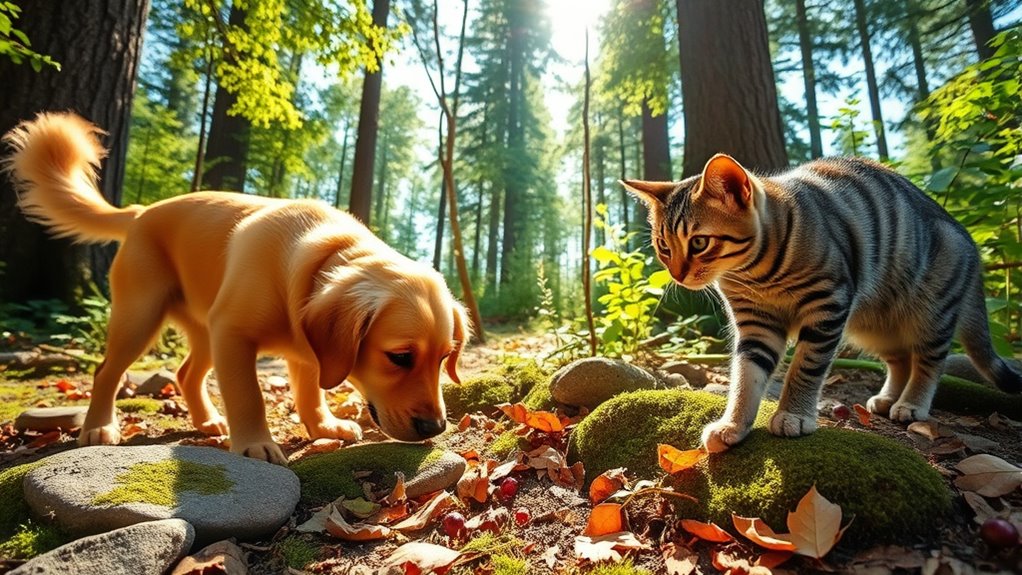
Engaging your pets in natural foraging activities taps into their instinctual behaviors and offers both mental and physical stimulation. Dogs enjoy sniffing mats and following scent trails, which mimic their hunting instincts and keep their minds sharp. Hide and seek with treats encourages problem-solving and active searching.
For cats, hiding food in different spots or using puzzle toys taps into their natural hunting and scavenging drives. Indoor options like hiding treats in paper bags or under blankets challenge their senses and keep them engaged. Using simple tools like scent mats, hay, or homemade puzzles transforms mealtime into an enriching experience.
Regularly changing up these activities prevents boredom and promotes natural behaviors, making foraging a crucial part of your pet’s mental health and overall well-being.
Benefits of Foraging for Pet Health and Well-being
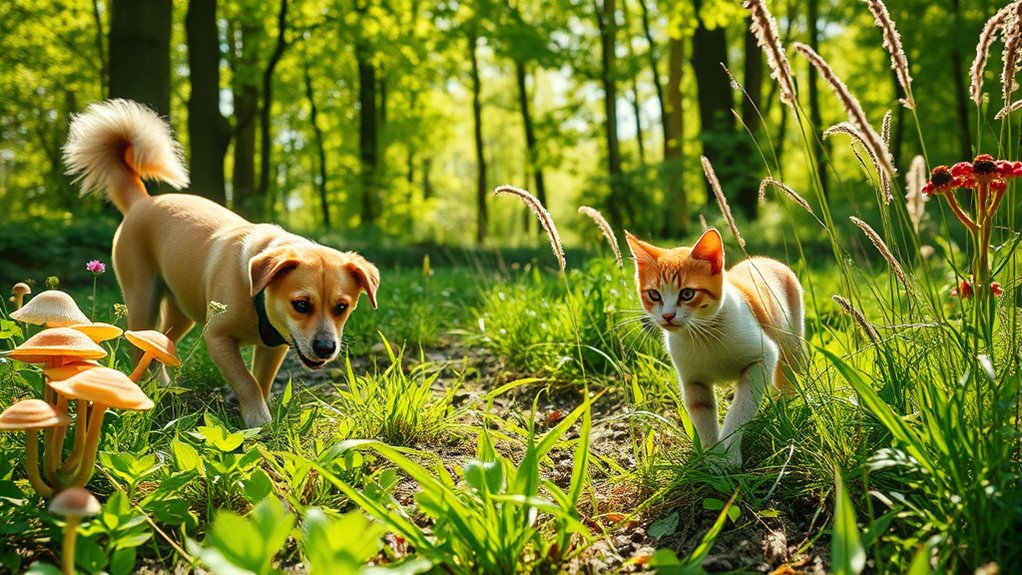
Foraging activities offer significant health benefits for your pets by promoting daily physical movement. When your pet engages in foraging, they exercise naturally, helping maintain a healthy weight and reducing obesity risks.
This activity also boosts cardiovascular health through increased activity levels and supports muscle tone and joint health by encouraging varied movements. Regular foraging can improve digestion and metabolism, leading to better overall bodily function. Additionally, engaging in foraging can strengthen your pet’s natural instincts, promoting behavioral resilience in various environments. Incorporating nutritional enrichment through foraging can further enhance their dietary variety and overall well-being.
Plus, it helps prevent boredom, which reduces stress-related behaviors that may harm health. Beyond the physical, foraging stimulates your pet’s mind, sharpening their problem-solving skills and scent-tracking abilities. Borderline Personality Disorder (BPD) can influence your pet’s environment and interactions, making mental stimulation especially important. Engaging in complex foraging tasks also encourages cognitive development, supporting mental agility and adaptability.
This mental engagement can reduce anxiety and behavioral issues, especially in senior pets. Overall, foraging enriches their physical and mental health, fostering happier, healthier lives.
Recognizing Safe Wild Foods for Dogs and Cats
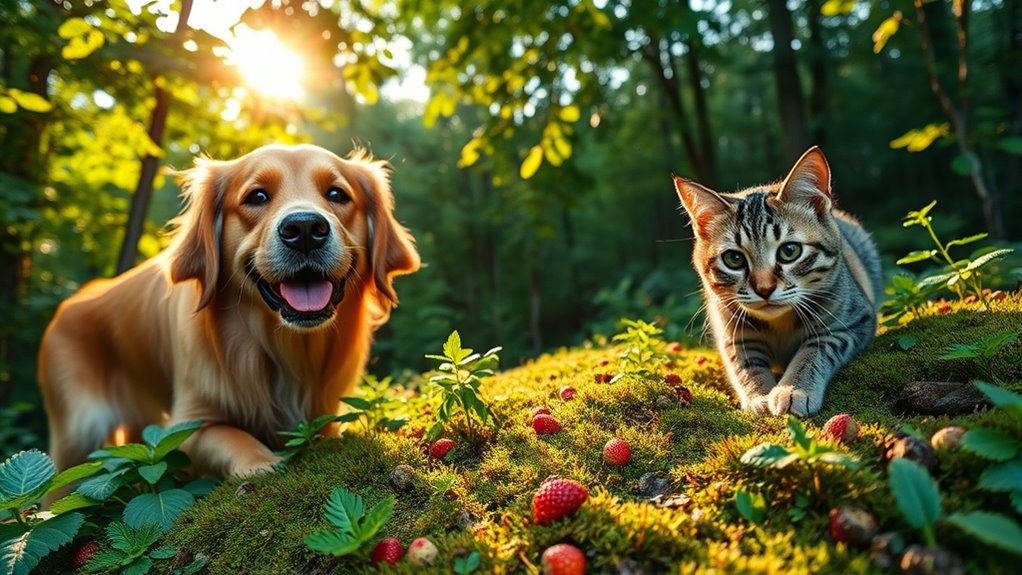
Recognizing which wild foods are safe for your dogs and cats is essential when incorporating natural foraging activities into their routine. Safe options include wild apples and berries like blueberries, but always remove seeds and pits. Using aesthetic wall organization solutions can also help keep foraging supplies and pet treats neatly stored. Freshly picked wild carrots and green beans can be healthy treats if thoroughly cleaned and prepared. Many wild grasses and herbs are safe for dogs to nibble on, adding variety to their diet. However, avoid feeding wild animals or parts, as they may carry diseases. Be cautious of toxic plants like garlic and onions, which are harmful to dogs. Always thoroughly clean wild foods, and consider freezing prey to reduce bacteria. Additionally, consulting your veterinarian can provide personalized advice tailored to your pet’s dietary needs and local environment. Proper food safety practices are crucial to prevent potential health issues from wild foraging. Data privacy challenges in technology highlight the importance of understanding potential health risks associated with wild foods and ensuring safe handling practices. Incorporating nutritional considerations into your foraging plans ensures your pets receive balanced and safe nutrition. Consider dog training tips to ensure your pet responds well during outdoor activities and remains safe.
Creating Stimulating Foraging Environments at Home
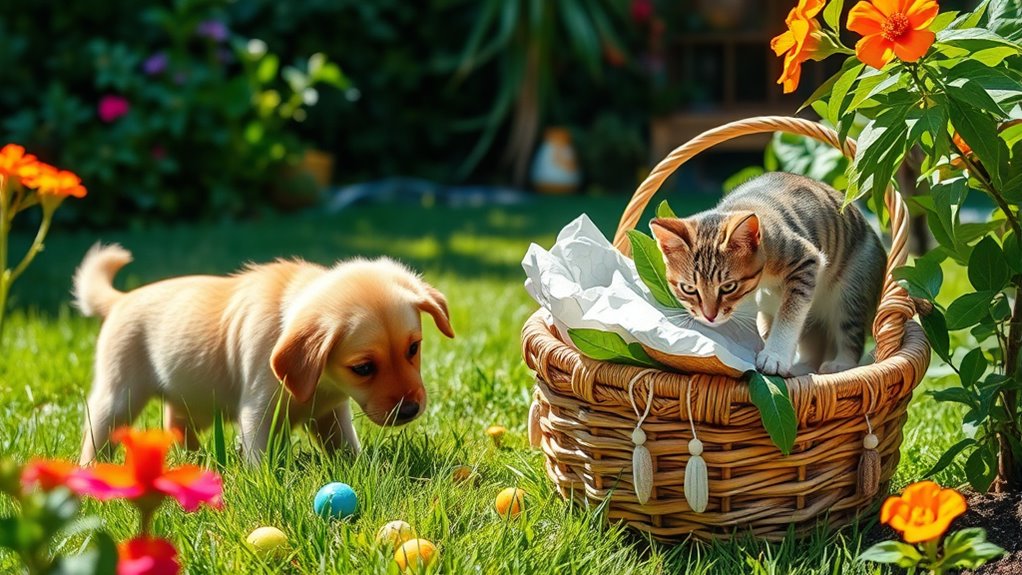
Creating stimulating environments at home is essential for satisfying your pets’ natural curiosity and foraging instincts. Use interactive feeders that challenge your dog or cat to work for their meals, boosting mental engagement. Scatter their food across larger areas to encourage searching and exploration. Hide treats in hard-to-reach spots or within hay piles to promote discovery. Incorporate species-appropriate foods like fruits and vegetables to align with natural dietary instincts. Stuff KONG toys with treats for prolonged foraging fun. Add sensory elements like snuffle mats and varied hay types to engage their sense of smell and sight. Create hiding spots filled with treats or hay, and set up foraging trails with hidden rewards. Regularly rotate items and layouts to keep their environment fresh and stimulating. Introducing foraging activities can also help prevent boredom and promote healthy behavior. Engaging in such enriching play can support your pet’s mental health and overall wellbeing. Understanding symptoms of breast cancer symptoms in humans can help in early detection and prompt treatment, similar to how providing engaging environments helps ensure your pets’ well-being.
Precautions for Safe Foraging and Food Handling
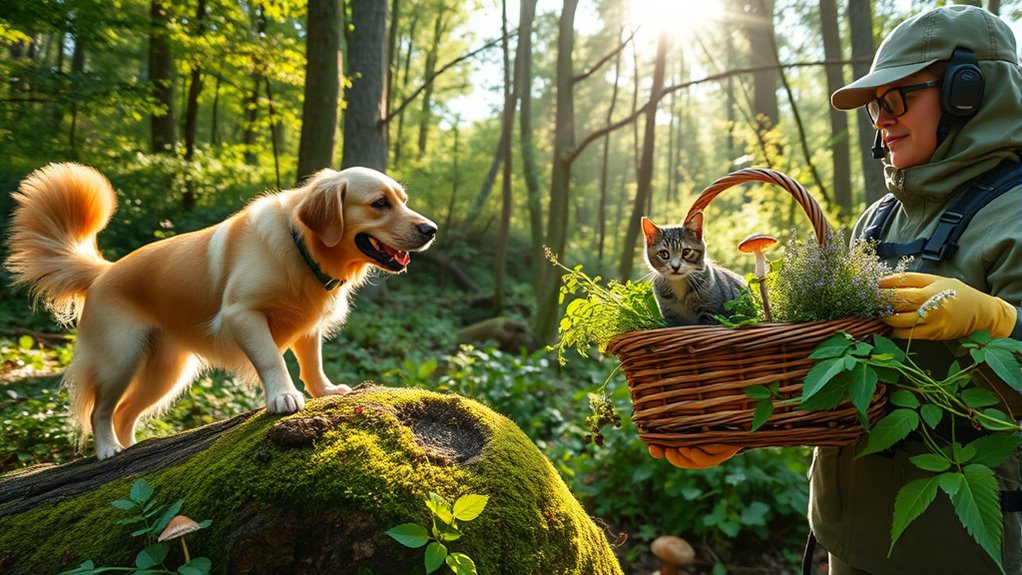
Ensuring safety during foraging and food handling is essential to protect both your pets and yourself. First, evaluate the terrain for hazards like steep slopes, water, or traps, and avoid areas with dog feces, which may contain harmful eggs.
Prioritize safety by inspecting terrain and avoiding contaminated areas during foraging.
Always identify plants correctly to prevent toxic ingestion and thoroughly wash foraged foods to remove contaminants. Keep your pets supervised and on a leash when necessary, and monitor their health after foraging for signs of illness.
Be aware of toxic plants, insects, and wildlife that could harm your pets. Use gloves when handling plants, store food properly, and prevent over-consumption. Recognizing air purification resources can help you stay informed about safe foraging practices and digital literacy.
Carry a pet first aid kit, know basic first aid procedures, and consult a vet if your pet shows symptoms of poisoning or ingests unknown plants.
Incorporating Foraging Into Daily Pet Routines

Incorporating foraging into your pet’s daily routine can turn active exploration into a natural part of their day. Schedule consistent foraging sessions around key times like meal prep or cleanup to build habits.
In the morning, engage your pet with active foraging tasks while preparing their meals, stimulating their mind early. Afterward, add social or training activities in the afternoon to balance mental and physical needs.
In the evening, switch to calmer enrichment activities like shreddable toys or tactile tasks to help them wind down. Adapt the duration and difficulty of foraging based on your pet’s age, species, and personality to keep them engaged without causing stress.
This routine encourages natural behaviors and enhances their overall well-being.
Tips for Monitoring and Adjusting Foraging Activities
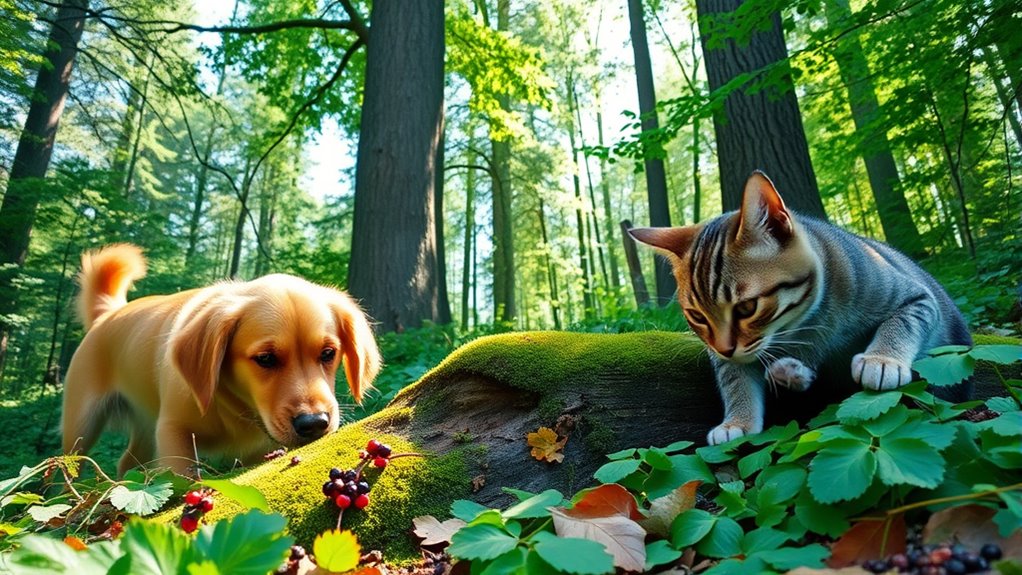
Monitoring and adjusting your pet’s foraging activities is essential to keep them safe and engaged. Start by supervising your pet with new toys to ensure they’re safe and to identify any issues. Using comfortable and supportive toys can also enhance their experience and reduce the risk of injury. Incorporating toys made from energy-efficient materials can further promote safety and durability. Adapt the difficulty level of foraging toys based on your pet’s skill—too hard can cause frustration, while too easy might bore them. Incorporate a mix of active and calming options to match their mood and environment. Regularly check toys for damage; discard any with chewed-off pieces. Tailor activities to your space, whether indoors or outdoors, and observe your pet’s reactions. Watch for signs of frustration or boredom and make changes accordingly. Rotating activities and offering positive reinforcement will keep your pet motivated and stimulated. Monitoring pet safety is crucial for a successful foraging experience and ensuring your pet’s well-being.
Frequently Asked Questions
How Often Should I Provide Foraging Activities for My Pet?
You should provide foraging activities to your pet daily, as it helps mimic their natural behaviors and keeps them mentally stimulated. Incorporate puzzles, hide treats, or rotate toys regularly to maintain their interest and challenge.
Consistent foraging diminishes unwanted behaviors, promotes physical and mental health, and strengthens your bond. Observe your pet’s responses and adjust the difficulty or variety to make certain they stay engaged and happy with their activities.
Are There Specific Wild Plants That Are Always Safe for Pets?
You want to know which wild plants are always safe for your pets. Some reliable options include Black-eyed Susan, Coneflower, and Goldenrod, which are native plants that won’t harm your furry friends.
Additionally, herbs like thyme, basil, and fennel are safe, along with flowers like snapdragons and asters.
Always double-check with trusted resources like the ASPCA and supervise your pets during foraging to prevent accidental ingestion of toxic plants.
Can Foraging Activities Replace a Traditional Pet Diet Entirely?
You might think foraging can be the be-all and end-all for your pet’s diet, but it’s a tall order. While it encourages activity and mental stimulation, it can’t replace traditional diets entirely.
Nutrients, vitamins, and minerals are tricky to balance naturally. Plus, safety concerns and limited scientific backing mean most vets recommend sticking to balanced, commercial foods to keep your pet healthy and happy.
How Can I Tell if My Pet Enjoys Foraging?
You can tell if your pet enjoys foraging by observing their behavior. Look for increased energy, active searching, and repeated engagement with foraging toys or environments.
Notice if they seem less bored or stressed and use their natural instincts like sniffing or exploring. When your pet enthusiastically seeks out foraging activities and shows enthusiasm, it’s a clear sign they genuinely enjoy the process and benefit from it.
What Are Signs of Adverse Reactions to Wild Foods in Pets?
Like a cautionary tale from a fairy tale, watch for your pet’s signs of trouble after foraging. Vomiting, diarrhea, or loss of appetite signal gastrointestinal distress.
Red, itchy skin, hives, or swelling suggest allergic reactions.
Breathing difficulties, coughing, or drooling point to respiratory issues.
Abdominal pain and unusual behavior should prompt immediate vet visits.
Stay vigilant, as wild foods can quickly turn from a treat to a threat for your furry friend.
Conclusion
Just like a detective uncovering hidden clues, embracing natural foraging keeps your pets curious and engaged. By understanding their instincts and providing safe, stimulating opportunities, you enrich their lives and promote their health. Remember, safety comes first—observe, adapt, and enjoy the journey together. When you nurture their natural instincts, you create a bond as strong as a sturdy tree, rooted in trust and adventure. Let your pets explore the wild side safely and happily.

